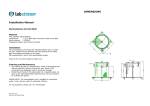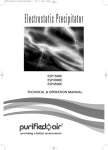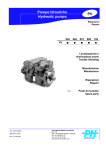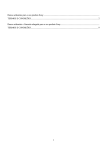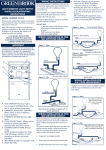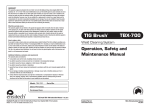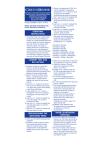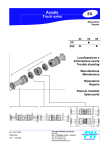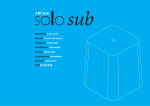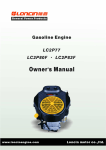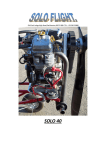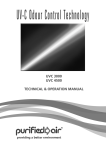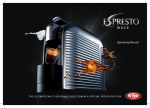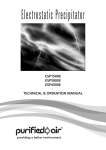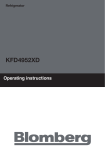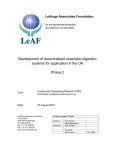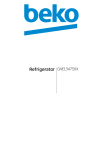Download ON 100 Odour Neutraliser - Commercial Kitchen Extraction Systems
Transcript
ON 100 Odour Neutraliser TECHNICAL & OPERATION MANUAL CK Direct 2010 All rights reserved. No part of this publication may be copied or published by means of printing, photocopying, microfilm or otherwise without prior written consent of the manufacturer. This restriction also applies to the corresponding drawings and diagrams. The information given in this document has been collected for the general convenience of our clients. It has been based on general data pertaining to construction material properties and working methods known to us at the time of issue of the document and is therefore subject at any time to change or amendment and the right to change or amend is hereby expressly reserved. The instructions in this publication only serve as a guideline for installation, use, maintenance and repair of the product mentioned on the cover page of this document. This publication is to be used for the standard model of the product of the type given on the cover page. Thus the manufacturer cannot be held responsible for any damage resulting from the application of this publication to the version actually delivered to you. This publication has been written with great care. However, the manufacturer cannot be held responsible, either for any errors occurring in this publication for their consequences. TAKE YOUR TIME TO CAREFULLY READ AND UNDERSTAND THE MANUAL BEFORE USING THE PRODUCT. ALWAYS KEEP THE MANUAL WITH THE PRODUCT. 1 PREFACE Using this manual This manual is intended to be used as a work of reference for professional, well trained and authorised users to be able to safely install, use, maintain and repair the product mentioned on the cover of this document. Please note that it is strongly recommended that training is given CK Direct by Purified AirLtd Ltd prior to operatives attempting to carry out maintenance or repair work on this product. Service and technical support For information about specific adjustments, maintenance or repair jobs which are not dealt with in this manual, please contact the supplier of the product. 2 SAFETY INSTRUCTIONS AND WARNINGS General The manufacturer does not accept any liability for damage to the product or personal injury caused by non-observance of the safety instructions in this manual, or by negligence during installation, use, maintenance and repair of the product mentioned on the cover of this document or corresponding accessories. Specific working conditions or used accessories may require additional safety instructions. Immediately contact your supplier if you detect a potential danger when using the product. The user of the product is always fully responsible for observing the local safety instructions and regulations. Observe all applicable safety instructions and regulations. User manual • Everyone working on or with the product must be familiar with the contents of this manual and must strictly observe the instructions therein. The management should instruct the personnel in accordance with the manual and observe all instructions and directions given. • Never change the order of the steps to perform • Always keep the manual with the product. Users • The use of this product is exclusively reserved to authorised, trained and qualified users. Temporary personnel and trainees can only use the product under supervision and responsibility of skilled engineers. Intended use The product has been designed exclusively for use in commercial kitchens. The product has been built in accordance with state-of the-art standards and recognised safety regulations. Only use the product in technically perfect condition with its intended use and the instructions laid down in the user manual. Safety features • All safety features must be correctly mounted and can only be removed for maintenance and repair jobs by skilled and authorised service engineers • The product must not be used if the safety features are only partly present or defective. • The safety features should be regularly checked for their proper functioning, and if required, be immediately repaired. Modifications A modification of the product is not allowed. Technical specifications The specifications given in this manual must not be altered. Modifications Modification of (parts of) the product is not allowed. Use general • Inspect the product and check it for damage. Verify the functioning of the safety features. • Check the working environment. Do not allow unauthorised persons to enter the working environment. • Use common sense. Stay alert and pay attention to your work. Do not use the product when you are tired or under the influence of drugs, alcohol or medicine. • Make sure the room is always sufficiently ventilated, particularly in smaller confined areas. • Never install the product in front of entrances and exits which must be used by emergency services. • Keep the operating controls free from dirt and grease. • The product is not explosion-proof rated. It can cause sparks and should therefore not be used in areas with an explosion risk. Use of O.N. 100 for commercial kitchen extraction • The product is suitable for the filtration of extracted fumes from commercial kitchens. • The product shall always be used in combination with the pre- and post-filters that are suitable for the particular kitchen involved. Service, maintenance and repairs This manual clearly makes a distinction between service maintenance and repair jobs which have to . be carried out by the user and those which have to be exclusively carried out by well trained and authorised service engineers. • Observe the maintenance intervals given in this manual. Overdue maintenance can lead to high costs for repairs and revisions and can render the guarantee null and void. • Always use tools, parts, materials, lubricants and service techniques that have been approved by the manufacturer. Never use worn tools and ensure that tools are not left behind in or on the product. • Do not carry out any service, maintenance or repairs on the product before it has been protected against unintended starting. • Safety features removed for servicing, maintenance or repair shall be re-installed immediately and checked for proper functioning. • Regularly clean the inside of the housing. • Clean or replace the filters in time. USED PRODUCTS AND THE ENVIRONMENT Packaging Material The purpose of the packaging is to protect the product during transport. It consists of the following substances that can be reused: - (corrugated) cardboard Do not dispose of the packaging material in the industrial waste Product Products which you would like to dispose of may still contain valuable substances and materials. Do not dispose of the product in the industrial waste. 1 TECHNICAL SPECIFICATIONS 1.1 Technical specifications O.N. 100 Power consumption Max capacity Weight Power Supply O.N. 100 40W 4.2m3/s 12.25 kg 220/240 V 50 Hz 1ph 2 GENERAL DESCRIPTION 2.1 O.N.100 in kitchen extraction applications The O.N.100 can remove odours from kitchen extract systems. The O.N. 100 is designed to be installed in the extraction ducting of a commercial kitchen downstream of the extraction hood and upstream of the extract fan. 2.2 Operation POSITIVELY L CHARGED GREASE NEGATIVEL A LY CHARGED ELIMINODOR T TION PARTICULATE A CONTROL UNIT COOKING CANOPY GREASE FILTER L FAN AIRFLOW DAMPER CONTROL VENTURI SPIGOT AMBIENT AIR O.N.100 The airstream must first be cleaned of the majority of particular contaminants leaving the gaseous phase of the contamination to be treated by the ON 100. Ambient air is drawn into the unit and mixed with the specially blended neatralising chemical (Eliminodor). A vapour is formed which is then ionised to a negative potential of 15,000 V. The ionised vapor passes along a nonconductive tube and is discharged into the centre of the duct via a venturi spigot, the metal ducting is earthed through the same high tension circuit which makes the contaminant at an opposite potential to the negatively charged vapor. The electrostatic difference between the contaminants and the neatralising vapour causes the two to combine electrically after which a chemical reaction takes place to treat the malodour.. 3 INSTALLATION Damper Control Fan Control Quick Release Locks High Voltage Top Up 3.1 Level Indicator O.N.100 Installation O.N. 100 The unit can be free standing on a flat surface or fixed to a wall or ducting (wherever the unit is positioned you should bare in mind that frequent access is required to replenish the neutralising fluid). Make sure that the unit is mounted level and upright. Once the unit is in place it can be electrically connected to a single-phase supply. The unit should be connected so as it only runs with the extract fan. It is also important to connect a earth lead to the ducting the unit will be serving (if the ducting is painted scrape this away to ensure continuity). The unit will not function properly if the ducting is not earthed as this conveys the electrostatic difference between the pollutant and the neutralizing fluid. Before proceeding further the control damper needs to be connected to the unit. This passes through the hole in the top of the outside casing and screws into the internal box. It is secured in place by screwing the flange attached to the damper to the case of the unit. Once the unit is in position and connected electrically test the operation prior to completion of the installation. On the inside of the unit you will see a small knob which is the speed controller for the fan used to agitate the neutralising fluid in the chamber. Turn the fan speed to full and fully open the damper and you should be able to detect the air coming out of the PVC pipe that the damper is connected to. Check that the controller alters the air volume as required. Now that the physical operation of the unit has been checked switch off the fan and unscrew the filler cap, pour the contents of the provided bottle of Eliminodor into the unit and replace the fillercap. Now switch the fan on and turn it to full, you should be able to detect a strong odour of Eliminodor. The system can now be switched off and the installation completed. The spigot must be installed at least one metre prior to the fan unit and if possible in a straight piece of ducting away from bends and other obstructions which will interrupt uniform airflow. The spigot has an outside diameter of 50 mm therefore you must drill a hole in the ducting to accommodate the spigot, this is normally done with a tank cutting drill bit. The spigot tip should be as close to the centre of the ducting as possible, if necessary the spigot can be cut if it is too long. The angled face of the spigot must face away from the airflow in order to establish a venturi effect, under no circumstances should the spigot be positioned otherwise as this can cause blow back and prevent the system from working at all. Once the spigot is in place it should be secured using self tapping screws through the flange. You will note that the flange is a tight push fit, when the final position is settled you may wish to fix the spigot to the flange to prevent any movement, this can be done using good quality PVC glue. The spigot can now be connected to the unit via the hose provided. Before pushing the hose onto the two connections place the jubilee clips over the hose. Once the hose is in place tighten two clips over the bottom connection and one over the spigot connection. Be sure not to over tighten the clips, as this will crack the pipe. 3.2 Commissioning O.N. 100 Now that the system is fully installed turn the fan to maximum and open the damper fully. Neutralising fluid should now be strongly detected at the exhaust point. To balance the system correctly wait until the kitchen is busy, neutralising fluid can still be detected then gradually decrease the output of the unit by tuning the knob anti-clockwise. When both odour and the neutralising fluid can be faintly detected, the unit is set correctly. Cooking odour may be detected at the discharge point but if you stand back a meter or so from the end of the duct you will note that the majority of the cooking odour has been neutralised. If after twenty minutes operation more than a trace of chemical can be seen in the spigot or the tube leaving the unit then the velocity is too high. Unless dealing with an extraordinarily odorous system the chemical is designed to evaporate into the system in very small quantities. To reduce the evaporation of the chemical close the damper gradually until the optimum setting is found. It may take some time to find this setting and it is recommended that this exercise be carried out over a period of a few hours to ensure that the settings are correct. 4 DIMENSIONS 4.1 Dimensions O.N.100 ServiceSpace Space Service Air Flow flow Air ON-100 O N-100 600 Plan Plan 200 Note: Note:IfIfaccess accessequipment equipmentisisnecessary necessary service servicerequirements requirementsmay mayvary. vary. Ductwork Ductwork Ductwork Ductwork ON-100 O N-100 505 Air Flow flow Air ON-100 O N-100 Side E levation Side Elevation levation Front E Elevation 405 5 MAINTENANCE 5.1 Periodic maintenance The amount of neutralising fluid consumed will depend on the type of cooking odour present and the volume of extract air, an average situation should use approximately one litre of fluid every three to four weeks. To refill the unit turn the unit off with the fan speed control knob on the front of the unit, remove the filler cap and pour in the liquid. The level of liquid required to ensure optimum performance is between the minimum and maximum lines on the site glass. Caution Over filling the unit may lead to damage. Once the unit has been filled replace the filler cap and return the fan speed control to its previous position. ONLY USE PURIFIED AIR “ELIMINODOR” AND NEVER ALLOW THE SYSTEM TO RUN DRY FOR MORE THAN TWENTY FOUR HOURS. 6 WIRING DIAGRAM N Ioniser # Fan L PCB Neon CK Direct CK Direct (Peterborough) Ltd Unit 9, Botolph Bridge Trading Estate, Purified Limited, Lyon House, Oundle Road,Air Peterborough PE2 9QP Lyon Road, Romford, Essex RM1 2BG Tel: 0808 1780001 Fax: 01733England 569433 Tel: 01708 755414 Fax: 01708 www.ckdirect.co.uk 721488 e-mail: [email protected] web: E-mail: enq@purifiedair.co.uk www.purifiedair.co.uk












